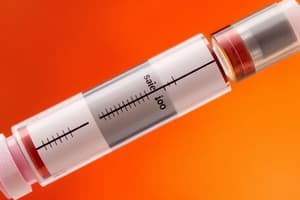Podcast
Questions and Answers
What is insulin lipodystrophy?
What is insulin lipodystrophy?
Insulin lipodystrophy is a term for fatty masses that develop at injection sites if they were not rotated properly.
What happens if someone injects insulin, and then does not eat afterwards?
What happens if someone injects insulin, and then does not eat afterwards?
They are at risk for hypoglycemia.
What is Metformin (Glucophage)?
What is Metformin (Glucophage)?
Metformin is a biguanide that reduces the production of glucose during digestion, helps reduce insulin resistance, and must be taken with meals.
What is the primary purpose of Sulfonylureas?
What is the primary purpose of Sulfonylureas?
Which insulin is typically given 30 minutes before meals?
Which insulin is typically given 30 minutes before meals?
What is polyphagia?
What is polyphagia?
If a person is at high risk for developing diabetes, what 2 diabetes tests can you assume their doctor will order?
If a person is at high risk for developing diabetes, what 2 diabetes tests can you assume their doctor will order?
A urine sample comes in from a newly diagnosed diabetic patient/resident. What may be abnormal about the sample you receive? (Select all that apply)
A urine sample comes in from a newly diagnosed diabetic patient/resident. What may be abnormal about the sample you receive? (Select all that apply)
What is diabetes?
What is diabetes?
What is insulin?
What is insulin?
Why is insulin important?
Why is insulin important?
What are the 4 types of diabetes?
What are the 4 types of diabetes?
What is Prediabetes?
What is Prediabetes?
What is Type 1 diabetes?
What is Type 1 diabetes?
What is Type 2 diabetes?
What is Type 2 diabetes?
What is gestational diabetes?
What is gestational diabetes?
What are risk factors for diabetes?
What are risk factors for diabetes?
What are symptoms of diabetes?
What are symptoms of diabetes?
What does the term 'non-fasting' mean?
What does the term 'non-fasting' mean?
What does the term 'fasting' mean?
What does the term 'fasting' mean?
What is hyperglycemia/high blood sugar?
What is hyperglycemia/high blood sugar?
What is hypoglycemia/low blood sugar?
What is hypoglycemia/low blood sugar?
What is stable diabetes?
What is stable diabetes?
What is unstable diabetes?
What is unstable diabetes?
What are the 3 P's of diabetes?
What are the 3 P's of diabetes?
How is diabetes diagnosed?
How is diabetes diagnosed?
What are some commonly used tests for diabetes?
What are some commonly used tests for diabetes?
How does the A1C/Glycohemoglobin test work?
How does the A1C/Glycohemoglobin test work?
How does the Fasting Plasma Glucose (FPG) test work?
How does the Fasting Plasma Glucose (FPG) test work?
How does the Oral Glucose Tolerance Test (OGTT) work?
How does the Oral Glucose Tolerance Test (OGTT) work?
How does the Random Plasma Glucose (RPG) test work?
How does the Random Plasma Glucose (RPG) test work?
How is Type 1 diabetes treated?
How is Type 1 diabetes treated?
How is Type 2 diabetes treated?
How is Type 2 diabetes treated?
Which type of diabetes can be cured once diagnosed?
Which type of diabetes can be cured once diagnosed?
How many types of insulin are there, and what are they?
How many types of insulin are there, and what are they?
What does 'onset' mean in insulin administration?
What does 'onset' mean in insulin administration?
What does 'peak' mean in insulin administration?
What does 'peak' mean in insulin administration?
What does 'duration' mean in insulin administration?
What does 'duration' mean in insulin administration?
What is important to remember about administering insulins?
What is important to remember about administering insulins?
What is a rapid-acting insulin?
What is a rapid-acting insulin?
What is a short/normal acting insulin?
What is a short/normal acting insulin?
What is an intermediate-acting insulin?
What is an intermediate-acting insulin?
What is a long-acting insulin?
What is a long-acting insulin?
What is an Ultra Long-acting Insulin?
What is an Ultra Long-acting Insulin?
What is a Pre-Mixed Insulin?
What is a Pre-Mixed Insulin?
What are the 3 main insulin distributors in the US?
What are the 3 main insulin distributors in the US?
What are Sulfonylureas?
What are Sulfonylureas?
What are Biguanides?
What are Biguanides?
What are Thiazolidinediones?
What are Thiazolidinediones?
What are Alpha-Glucosidase Inhibitors?
What are Alpha-Glucosidase Inhibitors?
What are Meglitinides?
What are Meglitinides?
What are Dipeptidyl Peptidase IV Inhibitors?
What are Dipeptidyl Peptidase IV Inhibitors?
What is a combination med that has a mix of 2 or more medication types?
What is a combination med that has a mix of 2 or more medication types?
Why is it important to rotate insulin injection sites?
Why is it important to rotate insulin injection sites?
What is ketoacidosis?
What is ketoacidosis?
What is insulin resistance?
What is insulin resistance?
What is insulin shock?
What is insulin shock?
What is Ketosis?
What is Ketosis?
What is Diaphoresis?
What is Diaphoresis?
What is a sign of peripheral arterial circulation?
What is a sign of peripheral arterial circulation?
What is NPH (Humulin N)?
What is NPH (Humulin N)?
Intermediate-acting insulins have a duration of?
Intermediate-acting insulins have a duration of?
You go into a diabetic resident/patient's room to find they have not eaten their snack. What do you do?
You go into a diabetic resident/patient's room to find they have not eaten their snack. What do you do?
What is the Somogyi Effect?
What is the Somogyi Effect?
How does an insulin pump work?
How does an insulin pump work?
What is the Dawn Phenomenon?
What is the Dawn Phenomenon?
What is a negative effect of using Prednisone (Deltasone)?
What is a negative effect of using Prednisone (Deltasone)?
What insulin type is Toujeo?
What insulin type is Toujeo?
What type of insulin is Lispro?
What type of insulin is Lispro?
What type of insulin is Humulin R?
What type of insulin is Humulin R?
What is a DiaBeta (Glyburide)?
What is a DiaBeta (Glyburide)?
What are some chronic complications associated with diabetes?
What are some chronic complications associated with diabetes?
Flashcards are hidden until you start studying
Study Notes
Diabetes Overview
- Diabetes is a metabolic disorder characterized by insufficient insulin production or ineffective insulin use.
- Four primary types of diabetes: Prediabetes, Type 1, Type 2, and Gestational.
Insulin Function
- Insulin is produced by the pancreas and converts carbohydrates and sugars into glucose for energy.
- It regulates blood sugar levels, playing a crucial role in metabolism.
Prediabetes and Diabetes Types
- Prediabetes: Higher than normal blood glucose levels but not high enough for a diabetes diagnosis; lifestyle changes can prevent Type 2 diabetes.
- Type 1 Diabetes: Typically diagnosed in children and young adults; involves little to no insulin production.
- Type 2 Diabetes: Occurs across all ages; characterized by the body's inability to use insulin properly.
- Gestational Diabetes: Happens during pregnancy; usually resolves postpartum but increases future Type 2 diabetes risk.
Risk Factors and Symptoms
- Common risk factors include overweight status, diet (high sugar and fat), inactivity, age (especially >45), family history, and ethnicity.
- Symptoms of diabetes include frequent urination, increased thirst, rapid weight changes, blurred vision, fatigue, and slow healing sores.
Blood Sugar Levels
- Hyperglycemia: Elevated blood sugar levels (over 140 mg/dL fasting, over 180 mg/dL non-fasting); symptoms include fatigue, blurred vision, and weight loss.
- Hypoglycemia: Low blood sugar (below 70 mg/dL); symptoms include shakiness, dizziness, confusion, and can lead to severe complications.
Diagnosis and Testing
- Diabetes diagnosis typically uses blood tests, including A1C, Fasting Plasma Glucose (FPG), Oral Glucose Tolerance Test (OGTT), and Random Plasma Glucose (RPG).
- A1C test reflects average blood glucose over three months without the need for fasting.
Treatment Approaches
- Type 1 Diabetes: Managed with daily insulin therapy, a balanced diet, and regular monitoring.
- Type 2 Diabetes: Treated with medications (insulin or pills), exercise, and dietary changes.
- Prediabetes: Often reversible through lifestyle modifications.
Insulin Types and Administration
- Types of Insulin: Include Rapid-Acting, Short-Acting, Intermediate-Acting, Long-Acting, Ultra Long-Acting, and Pre-Mixed.
- Key parameters for insulin:
- Onset: Time until insulin starts lowering blood sugar.
- Peak: Time at which insulin reaches maximum strength.
- Duration: Length of time insulin remains effective.
- Importance of rotating injection sites to prevent lipodystrophy and ensure consistent absorption.
Medications and Complications
- Sulfonylureas stimulate insulin production, while Biguanides (like Metformin) reduce glucose production and increase insulin sensitivity.
- Chronic complications from diabetes can include retinopathy, neuropathy, and coronary artery disease.
- Insulin shock results from excessive insulin leading to hypoglycemia, which can be life-threatening.
- Diabetic ketoacidosis is a serious condition in Type 1 diabetics resulting from high ketone levels.
Monitoring and Lifestyle Guidelines
- Regular glucose monitoring is essential for all diabetes types.
- Diet, exercise, and weight management are critical in controlling and preventing diabetes, especially for at-risk populations.
Behavioral Considerations
- Recognize the effects of stress, illness, or irregular meal patterns on blood sugar levels.
- Encourage consistent dietary habits and prompt reporting of any changes in symptoms or insulin needs.
Studying That Suits You
Use AI to generate personalized quizzes and flashcards to suit your learning preferences.




